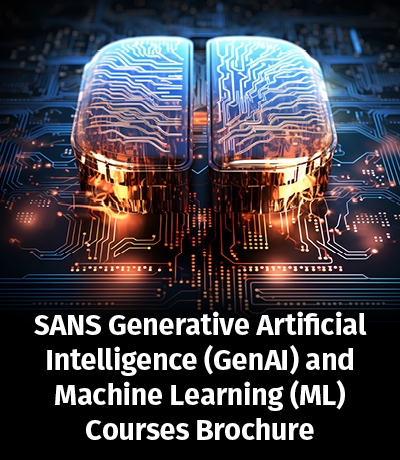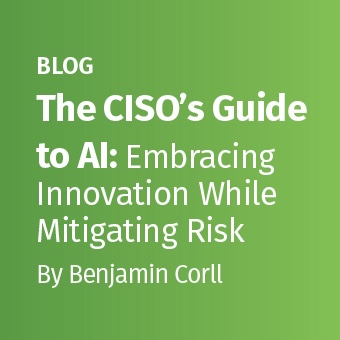This webcast dives into the intersection of AI and cybersecurity, featuring insights from top experts at Google DeepMind, Anthropic, and OpenAI. It discusses how AI is reshaping cybersecurity, the critical role of expertise and data in building AI models, and the potential of AI tools like Large Language Models in identifying vulnerabilities. If you're curious about the evolving threats AI could bring and how leading minds are tackling these challenges, this is a must-watch.
Trending AI News & Updates
Generative Artificial Intelligence Insights
Join Frank Kim, SANS Fellow, as he guides you through the exciting opportunities Generative AI offers for today's business leaders, potential risks, and how to prepare yourself and your organization, to mitigate those risks.
AI/ML Technology-Focused Courses
AI/ML Integration-Enhanced Courses
The SANS AI/ML Courses Roadmap provides a summary of the Generative AI (GenAI) and Machine Learning (ML) technology-focused courses and integration-enhanced courses available at SANS. These courses are designed to equip cybersecurity professionals with essential skills to navigate AI-related complexities and improve security measures. The roadmap highlights specialized training in AI/ML for various applications such as security automation, threat detection, forensic analysis, offensive AI techniques, and practical applications of data science and machine learning in cybersecurity.
AI Research and Whitepapers
Cybersecurity AI FAQS
What is AI Cybersecurity?
AI cybersecurity is using artificial intelligence and machine learning to enhance the security of digital systems and networks. It encompasses a wide array of tasks, from real-time threat detection and automated incident response to vulnerability assessment and user behavior analysis.
AI-powered cybersecurity solutions can function autonomously or assist human operators, providing valuable insights and aiding in decision-making processes. Engineers can design AI to predict, detect, and mitigate cyber threats efficiently, thereby reducing the risks associated with data breaches and system vulnerabilities.
How Can AI Help Cybersecurity?
Real-Time Threat Detection
One of AI's most notable contributions to cybersecurity is its ability to identify threats in real time. Machine learning models can analyze network traffic, system logs, and user behavior to spot anomalies that human operators might miss. They can recognize patterns of malicious activities and initiate immediate responses, mitigating potential damage.
Predictive Analysis
AI cybersecurity systems use historical data and sophisticated algorithms to predict potential vulnerabilities and cyber threats. By analyzing past attack patterns, AI can anticipate future attacks and help organizations fortify their defenses accordingly.
Automated Incident Response
In the event of a security breach, AI can swiftly respond by isolating compromised systems, blocking malicious activity, and restoring operations to a secure state. This automation saves valuable time and minimizes the impact of cyberattacks.
What are some Advantages of AI Cybersecurity?
AI cybersecurity presents numerous advantages that make it an indispensable asset in the digital age:
Speed and Efficiency
AI can process vast amounts of data in real time, making it exceptionally quick at identifying and responding to threats. This speed can be critical in preventing cyberattacks from causing significant damage.
Constant Vigilance
Unlike humans who need rest, AI systems work 24/7, providing uninterrupted protection against cyber threats. They don't get tired, distracted, or make mistakes due to fatigue.
Scalability
AI solutions can easily scale to meet the growing demands of an organization. Whether you have a small business or a large enterprise, AI can adapt to your needs.
Reduced False Positives
AI's ability for in-depth data analysis leads to fewer false alarms or false positives. This means that security teams can focus their attention on legitimate threats, improving overall efficiency.
What are some examples of AI Cybersecurity Examples
Antivirus Software
Modern antivirus software employs AI algorithms to identify and block malware. AI can quickly recognize new threats, even those with no known signatures, by analyzing their behavior.
User Authentication
AI-based authentication systems can analyze user behavior, such as typing patterns and mouse movements, to detect unauthorized access and thwart account breaches.
Email Filtering
AI is commonly used in email security to filter out phishing emails and spam. It can recognize patterns in email content and sender behavior that indicate malicious intent.
Network Intrusion Detection
AI-powered intrusion detection systems monitor network traffic for suspicious activity and can respond in real time to block potential threats.
What are some AI Cybersecurity Solutions?
As cybersecurity threats evolve, AI continues to advance its capabilities. Here are some potential solutions and considerations to further enhance AI cybersecurity:
Improved AI Training
Investing in more extensive training data sets and better AI models can lead to more accurate threat detection and reduced false positives.
Interoperability
Organizations should make every effort to ensure that AI cybersecurity systems can work seamlessly with existing infrastructure, promoting easy adoption and integration.
Regulatory Frameworks
Government and industry must establish regulations and standards for the ethical and responsible use of AI cybersecurity technologies.
AI-Empowered Human Teams
We must see AI as a complement to human expertise, not a replacement. Human-AI collaboration can provide the best of both worlds in terms of cybersecurity defense.



